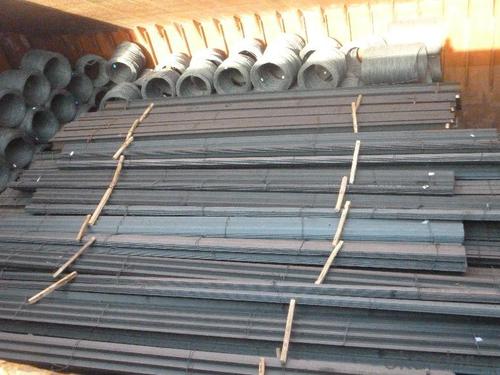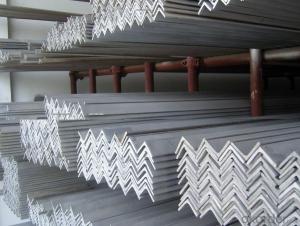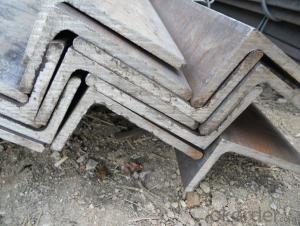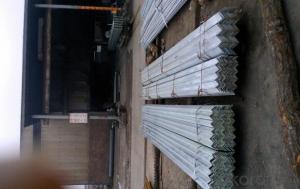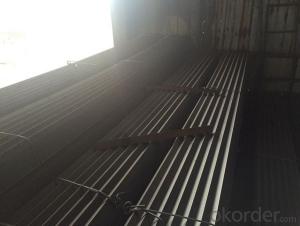Hot Rolled Steel Equal Bars for Construction of Warehouses
- Loading Port:
- Tianjin
- Payment Terms:
- TT OR LC
- Min Order Qty:
- 25 m.t.
- Supply Capability:
- 200000 m.t./month
OKorder Service Pledge
OKorder Financial Service
You Might Also Like
Product Description:
OKorder is offering Hot Rolled Steel Equal Bars for Construction of Warehouses at great prices with worldwide shipping. Our supplier is a world-class manufacturer of steel, with our products utilized the world over. OKorder annually supplies products to European, North American and Asian markets. We provide quotations within 24 hours of receiving an inquiry and guarantee competitive prices.
Product Applications:
Hot Rolled Steel Equal Bars for Construction of Warehouses are ideal for structural applications and are widely used in the construction of buildings and bridges, and the manufacturing, petrochemical, and transportation industries.
1. Supporting members, most commonly in the house raising industry to strengthen timber bears under houses. Transmission line towers, etc
2. Prefabricated structure
3. Medium scale bridges
4. It is widely used in various building structures and engineering structures such as roof beams, bridges, transmission towers, hoisting machinery and transport machinery, ships, industrial furnaces, reaction tower, container frame and warehouse etc.
Product Advantages:
Hot Rolled Steel Equal Bars for Construction of Warehouses are durable, strong, and resist corrosion.
Main Product Features:
· Premium quality
· Prompt delivery & seaworthy packing (30 days after receiving deposit)
· Corrosion resistance
· Can be recycled and reused
· Mill test certification
· Professional Service
· Competitive pricing
Product Specifications:
1.Standards:GB,ASTM,BS,AISI,DIN,JIS
2.Length:6m,9m,12m
3.Material:GBQ235B,Q345BorEquivalent;ASTMA36;EN10025,S235JR,S355JR;JISG3192,SS400;SS540.
4. Sizes
Sizes: 25mm-250mm | ||
a*t | ||
25*2.5-4.0 | 70*6.0-9.0 | 130*9.0-15 |
30*2.5-6.6 | 75*6.0-9.0 | 140*10-14 |
36*3.0-5.0 | 80*5.0-10 | 150*10-20 |
38*2.3-6.0 | 90*7.0-10 | 160*10-16 |
40*3.0-5.0 | 100*6.0-12 | 175*12-15 |
45*4.0-6.0 | 110*8.0-10 | 180*12-18 |
50*4.0-6.0 | 120*6.0-15 | 200*14-25 |
60*4.0-8.0 | 125*8.0-14 | 250*25 |
5.Material details:
Alloy No | Grade | Element (%) | |||||
C | Mn | S | P | Si | |||
Q235 | B | 0.12—0.20 | 0.3—0.7 | ≤0.045 | ≤0.045 | ≤0.3 | |
Alloy No | Grade | Yielding strength point( Mpa) | |||||
Thickness (mm) | |||||||
≤16 | >16--40 | >40--60 | >60--100 | ||||
≥ | |||||||
Q235 | B | 235 | 225 | 215 | 205 | ||
Alloy No | Grade | Tensile strength (Mpa) | Elongation after fracture (%) | ||||
Thickness (mm) | |||||||
≤16 | >16--40 | >40--60 | >60--100 | ||||
≥ | |||||||
Q235 | B | 375--500 | 26 | 25 | 24 | 23 | |
FAQ:
Q1: How do we guarantee the quality of Hot Rolled Steel Equal Bars for Construction of Warehouses?
A1: We have established an advanced quality management system which conducts strict quality tests at every step, from raw materials to the final product. At the same time, we provide extensive follow-up service assurances as required.
Q2: Can fit in the containers of 20fts Hot Rolled Steel Equal Bars of 6M?
A2: No problem, we can put them into the containers in the form sideling.
Q3: The products are invoicing on theoritical weight or on actual weight?
A3: We can do it in both manners, according to the customers' requestof 6M?
- Q: Can steel angles be used in signage?
- Yes, steel angles can be used in signage. Steel angles are versatile and durable structural components that can be easily fabricated and installed in various applications, including signage. They provide excellent strength and stability, making them suitable for supporting heavy or large signs. Additionally, steel angles can be welded, bolted, or riveted together, allowing for flexibility in design and customization. They can be painted or coated to enhance their appearance and protect against corrosion, ensuring the longevity of the signage. Overall, steel angles offer a reliable and robust solution for signage installations.
- Q: Can steel angles be used in the construction of staircases?
- Yes, steel angles can be used in the construction of staircases. Steel angles are commonly used as structural components in construction due to their strength and versatility. In the case of staircases, steel angles can be used to provide support and stability to the overall structure. They can be used to create the framework for the stairs, supporting the treads and risers. Additionally, steel angles can be used as handrails or guardrails, providing a sturdy and secure grip for users. Overall, steel angles are a popular choice for constructing staircases due to their durability, load-bearing capacity, and aesthetic appeal.
- Q: How to determine the neutral axis of the angle bar?
- For the bolt group, the calculation of the location of the neutral axis is more complex, and is usually approximately assumed on the bottom row of the bolt axis.
- Q: How do you determine the plastic section modulus of a steel angle?
- In order to determine the plastic section modulus of a steel angle, a specific calculation process must be followed. The plastic section modulus (Z) is used to assess the ability of a cross-section to resist plastic bending and is commonly employed in structural engineering to analyze the strength and stability of members. To calculate the plastic section modulus of a steel angle, it is necessary to know the dimensions of the angle cross-section, including the length of the legs and the thickness of the steel. Once these measurements are obtained, the following steps can be carried out: 1. The centroid of the angle cross-section must be identified. This centroid serves as the geometric center of the shape and is a crucial reference point for calculating the plastic section modulus. By determining the average of the coordinates of the vertices, the centroid can be found. 2. The moment of inertia (I) needs to be calculated. The moment of inertia provides a measure of how the area is distributed around the centroid. It can be determined by summing the individual moments of inertia for each component of the cross-section. For a steel angle, the moment of inertia can be calculated using standard formulas or tables. 3. The plastic section modulus (Z) must be determined. The plastic section modulus is directly related to the moment of inertia. It can be computed by dividing the moment of inertia (I) by the distance from the centroid to the outermost fiber of the section. This distance, known as the distance to the extreme fiber (c), is typically equal to half the thickness of the angle. The formula to calculate the plastic section modulus (Z) is Z = I / c. 4. The values obtained for the moment of inertia (I) and the distance to the extreme fiber (c) should be substituted into the formula to calculate the plastic section modulus (Z). By following these steps, the plastic section modulus of a steel angle can be determined. This parameter is crucial for assessing the structural behavior and design of steel angles, particularly when subjected to bending loads.
- Q: Can steel angles be used for manufacturing storage racks?
- Yes, steel angles can be used for manufacturing storage racks. Steel angles are strong and durable, making them suitable for supporting heavy loads in storage rack systems. Additionally, their shape allows for easy assembly and customization of storage rack designs.
- Q: Can steel angles be used for ladder rungs?
- Yes, steel angles can be used for ladder rungs. Steel angles are often used in construction and fabrication for their strength and durability. They can provide a solid and secure surface for climbing on ladders. However, it is important to take into consideration the specific requirements and regulations for ladder rungs, such as the dimensions, spacing, and anti-slip properties. These factors ensure the safety and stability of the ladder for users. It is recommended to consult relevant safety guidelines and standards before using steel angles as ladder rungs.
- Q: Are steel angles resistant to pests and insects?
- Pests and insects do not find steel angles naturally repellent. Although pests generally do not find steel appealing, it is possible for steel angles to be vulnerable to infestation or harm in the presence of openings or gaps that allow pests to enter. Moreover, pests can still inflict damage on nearby materials, indirectly impacting the overall strength of the steel angles. Hence, it is crucial to implement effective pest control measures and promptly address any potential entry points or weaknesses to reduce the likelihood of pest infestation or harm to steel angles.
- Q: What is the minimum thickness for a steel angle?
- The minimum thickness for a steel angle typically depends on the specific application and the load it needs to bear. However, in general, steel angles are available in various thicknesses ranging from 1/8 inch to 1 inch or more.
- Q: Are steel angles resistant to fire?
- Steel angles are generally considered to be fire resistant. Steel is a non-combustible material, meaning it does not burn or contribute to the spread of fire. However, it is important to note that while steel itself is resistant to fire, it can lose its strength when exposed to high temperatures for an extended period of time. In a fire situation, the temperature can rise rapidly, causing the steel to weaken and potentially compromise the structural integrity of a building or component. To enhance fire resistance, steel angles can be protected by applying fire-resistant coatings, such as intumescent paint or fireproofing materials. These coatings can provide additional insulation, delaying the steel's exposure to high temperatures and preventing its failure. Ultimately, the fire resistance of steel angles depends on various factors, including the duration and intensity of the fire, as well as the measures taken to enhance their fire performance. It is essential to consult with fire protection experts and adhere to building codes and regulations to ensure the appropriate level of fire resistance for steel angles in a specific application.
- Q: Can steel angles be used as reinforcing bars in concrete structures?
- Yes, steel angles can be used as reinforcing bars in concrete structures. Steel angles are commonly used for this purpose due to their strength and durability. They provide additional strength to the concrete, preventing cracks and increasing the overall stability of the structure. Steel angles are typically embedded in the concrete to provide reinforcement in areas where additional support is required, such as in beams, columns, and slabs. They are commonly used in construction projects such as bridges, buildings, and other concrete structures.
Send your message to us
Hot Rolled Steel Equal Bars for Construction of Warehouses
- Loading Port:
- Tianjin
- Payment Terms:
- TT OR LC
- Min Order Qty:
- 25 m.t.
- Supply Capability:
- 200000 m.t./month
OKorder Service Pledge
OKorder Financial Service
Similar products
Hot products
Hot Searches
Related keywords



